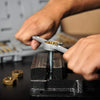
DIY Air Compressor Maintenance: How to Keep Your Air Compressor Running Smoothly
Air compressors are essential tools for DIY enthusiasts, handymen, and professionals alike. From inflating tires to powering air tools, these versatile machines are an invaluable addition to any workshop or garage.
However, just like any other piece of equipment, air compressors require regular maintenance to ensure they continue to run smoothly and efficiently. In this in-depth guide, we will provide you with the knowledge and tips necessary to keep your air compressor in top working condition.
Table of Contents
- Importance of Air Compressor Maintenance
- Understanding the Components of Your Air Compressor
- Daily Maintenance Tasks
- Weekly Maintenance Tasks
- Monthly Maintenance Tasks
- Annual Maintenance Tasks
- Troubleshooting Common Issues
- Conclusion
1. Importance of Air Compressor Maintenance
Proper maintenance of your air compressor is crucial for several reasons:
- Efficiency: A well-maintained air compressor will operate more efficiently, saving you money on energy costs.
- Longevity: Regular maintenance can greatly extend the life of your air compressor, preventing premature wear and costly repairs.
- Safety: Keeping your air compressor in good working order can help prevent accidents and injuries caused by equipment failure.
- Performance: A well-maintained air compressor will deliver consistent performance, ensuring that your air tools function as intended.
By following the recommended maintenance schedule and procedures outlined in this guide, you can protect your investment and enjoy years of trouble-free operation from your air compressor.
2. Understanding the Components of Your Air Compressor
Before diving into the maintenance tasks, it's important to familiarize yourself with the main components of your air compressor:
- Motor: The motor powers the air compressor, converting electrical energy into mechanical energy.
- Pump: The pump is responsible for compressing the air and increasing its pressure.
- Air Tank: The air tank stores the compressed air until it's needed for use.
- Pressure Regulator: The pressure regulator controls the pressure of the air being released from the tank.
- Air Hose and Fittings: The air hose and fittings connect your air compressor to your air tools and accessories.
- Filters and Lubrication System: These components help keep your air compressor clean and properly lubricated.
Understanding how these components work together will help you identify potential issues and perform the necessary maintenance tasks to keep your air compressor running smoothly.
Related Article: Portable Air Compressors For Your Home
3. Daily Maintenance Tasks
Performing daily maintenance on your air compressor is essential for ensuring its optimal performance and longevity. Here are the key tasks you should complete each day before using your air compressor:
- Check the Oil Level: If your air compressor is oil-lubricated, make sure the oil level is within the recommended range. Add oil if necessary, but do not overfill.
- Inspect the Air Filter: Check the air filter for dirt and debris. Clean or replace the filter if necessary to ensure proper airflow and prevent damage to the motor and pump.
- Drain the Air Tank: Condensation can build up in the air tank, which can cause rust and other issues if left unchecked. Open the drain valve at the bottom of the tank to release any accumulated moisture.
- Examine Hoses and Fittings: Inspect the air hose and fittings for signs of wear, cracks, or leaks. Replace any damaged components to prevent air leaks and maintain proper pressure.
- Verify Proper Operation: Turn on the air compressor and check for any unusual noises, vibrations, or other signs of trouble. Address any issues before they become more serious problems.
4. Weekly Maintenance Tasks
In addition to daily checks, there are several maintenance tasks that should be performed on a weekly basis:
- Clean the Air Intake Vents: Remove any dust, dirt, or debris that may have accumulated on the air intake vents. This will help ensure proper airflow and prevent overheating.
- Inspect the Belt (if applicable): If your air compressor uses a belt-driven motor, check the belt for signs of wear, cracks, or fraying. Adjust the belt tension if necessary, and replace it if it shows signs of damage.
- Check the Safety Valve: The safety valve is designed to release excess pressure in the event of a malfunction. Test the valve by pulling on the ring to ensure it operates freely. If the valve is stuck or does not release air, it should be replaced immediately.
5. Monthly Maintenance Tasks
To keep your air compressor in optimal condition, there are also several tasks that should be performed on a monthly basis:
- Replace the Air Filter (as needed): Depending on the frequency of use and the environment in which it's used, your air compressor's air filter may need to be replaced more often than the manufacturer's recommendation. Check the filter regularly and replace it as needed to ensure proper airflow.
- Clean the Exterior: Wipe down the exterior of the air compressor with a damp cloth to remove dust, dirt, and other debris. Keeping the exterior clean can help prevent clogs and other issues.
- Inspect the Motor and Pump: Visually inspect the motor and pump for signs of wear, corrosion, or damage. Address any issues promptly to prevent further damage.
6. Annual Maintenance Tasks
Finally, there are some maintenance tasks that should be performed at least once per year:
- Change the Oil (oil-lubricated models): If your air compressor is oil-lubricated, the oil should be changed at least once per year, or more frequently if the manufacturer recommends it.
- Inspect the Air Tank: Check the interior of the air tank for signs of rust or corrosion. If any issues are found, have the tank professionally inspected and repaired or replaced as necessary.
- Replace the Pressure Regulator (if needed): Over time, the pressure regulator may become less accurate or fail altogether. If you notice inconsistent pressure or other issues related to the regulator, have it replaced.
7. Troubleshooting Common Issues
Despite your best efforts to maintain your air compressor, issues may still arise. Here are some common problems and their possible causes:
- Air Compressor Won't Start: This could be due to a blown fuse, a tripped circuit breaker, or an issue with the power supply. Check the electrical connections and replace any damaged components.
- Insufficient Pressure: This may be caused by a damaged or worn hose, fittings, or seals. Replace any damaged components and ensure all connections are tight.
- Excessive Noise or Vibration: Loose or worn parts, such as the motor mounts or belt, can cause excessive noise or vibration. Tighten any loose connections and replace worn parts.
- Overheating: Dirty or clogged air filters, vents, or cooling fins can cause overheating. Clean these components regularly to ensure proper airflow and prevent overheating.
Related Article: DIY Air Compressors
Conclusion
In conclusion, proper maintenance is essential for keeping your air compressor running smoothly and efficiently. By following the guidelines and tips outlined in this comprehensive guide, you can ensure that your air compressor continues to serve you well for years to come.
Regular inspections, cleaning, and component replacements will not only extend the life of your air compressor but also improve its performance and safety.
So, roll up your sleeves and take charge of your air compressor maintenance – your tools and projects will thank you!
Related Article: Find the Best Air Compressor for Your Needs



